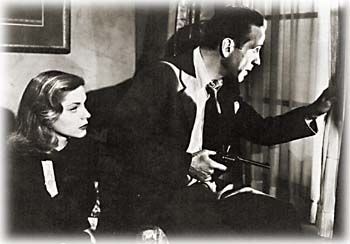![[Metroactive Movies]](/movies/gifs/movies468.gif)
![[Metroactive Movies]](/movies/gifs/movies468.gif)
[ Movies Index | Metro | Metroactive Central | Archives ]
Big Gumshoes to Fill
 Hiding From the Smog: Humphrey Bogart and Lauren Bacall take a suspicious look at L.A. in "The Big Sleep." 'Maltese Falcon' and restored 'Big Sleep' both star Humphrey Bogart but are as different as San Francisco and Los Angeles The Maltese Falcon (1941) and The Big Sleep (1946), playing Feb. 6-9 at the Stanford Theater in Palo Alto, take place in two different stages of Humphrey Bogart's career. In one double bill, he transforms himself from "Humphrey," still upper-crust, composing himself in a dainty smile while he rolls a cigarette in The Maltese Falcon, to "Bogart" (a.k.a. "Doghouse Reilly"), the weathered detective of The Big Sleep. The two films offer telling snapshots of the actor--of the movies, of the entire country--before and after WWII. "In 1539, the knights Templar of Malta paid tribute to Charles V of Spain, by sending him a Golden Falcon encrusted from beak to claw with rarest jewels--but pirates seized the galley carrying the priceless token, and the fate of the Maltese Falcon remains a mystery to this day." So read the opening titles of The Maltese Falcon, the immortal and immoral story of San Francisco gumshoe Sam Spade. Not a man who worships the truth himself, Spade becomes involved with a whole troop of really professional liars, one of whom (Sydney Greenstreet) tells a version of the whopper above. Spade develops a sort of tic, a snarl, from smelling so many bullshit stories. Mary Astor, as an expensively slutty beauty who takes the alias "Mrs. Wunderlich" (Mrs. Wonderful), is nearly good enough a fibber to convince the detective that love conquers all. Love may not do the trick, but luck can. John Huston, in his debut as a director, had good luck all the way through The Maltese Falcon, luck made better by an incomparable cast, topped, I think, by Peter Lorre, playing a scented, Pan-like little devil named Joel Cairo. Like a Home Movie The Maltese Falcon will be screened in conjunction with a restored version of The Big Sleep. This edition, different in a few minutes from the one originally released to theaters, was discovered in the vaults. The extra footage, pieced together by the UCLA Film Archive, helps to sort out the story's famously tangled narrative. Detective Philip Marlowe (Bogart) is hired to keep tabs on a millionaire's nymphomaniac daughter. In tracing her, he becomes wrapped up with blackmailers and murderers. No one has ever cared as much about the plot as they have about Howard Hawks' staggeringly impudent direction--or as much as they cared for Lauren Bacall, who plays the tough good girl who decides to assist Marlowe. The Big Sleep is all style and little substance, but what confident style--"like a home movie," David Thompson writes, describing film's effortlessness. The 50-year-old tale is more vivid and fresh than most of the movies that will come out next week. And it's more even-keeled about sex than the current crop. Most who see The Big Sleep can't get over the best zipless sex scene in American cinema, the one in which bookshop keeper Dorothy Malone impulsively decides to entertain herself for a hour during one of those miserable California monsoons. In Love With La-La Land Spade and Marlowe are two of the best-known characters in California fiction. If Bogart, who played them both, wasn't an actor with a great range, he had enough range to makes the nuances of these two characters strikingly different. Both are part of the outsider's vision of California as the land of the pagans. Marlowe, the creation of British-to-the-garters novelist Raymond Chandler, was a sort of colonial policeman in the Los Angeles tropics, keeping his morality while all about him are losing theirs. Critic Manny Farber wrote that The Big Sleep tales place in "Bagdadish" surroundings. If so, Hawks and his various screenwriters grasped the essence of a Los Angeles of heat, sea, spiny flowers and smog-filtered full moons that look like rotten oranges. Dashiell Hammett's Sam Spade lived happily with his moral fog in a city that the late Herb Caen (RIP) used to call "Bagdad by the Bay." Foreigners love the exotic qualities of these two movies, these Tahitian dreams of freedom; and Americans love Bogart's eventual triumph over the temptation to go native, convincing us (as he has convinced generations before) that there's something attractive about having a conscience--even while keeping it, with much effort, at the limits of the known world.
[ Metro | Metroactive Central | Archives ]
| ||||||||||||||||||||||||||||||
This page was designed and created by the Boulevards team.
Copyright © 1997 Metro Publishing, Inc.